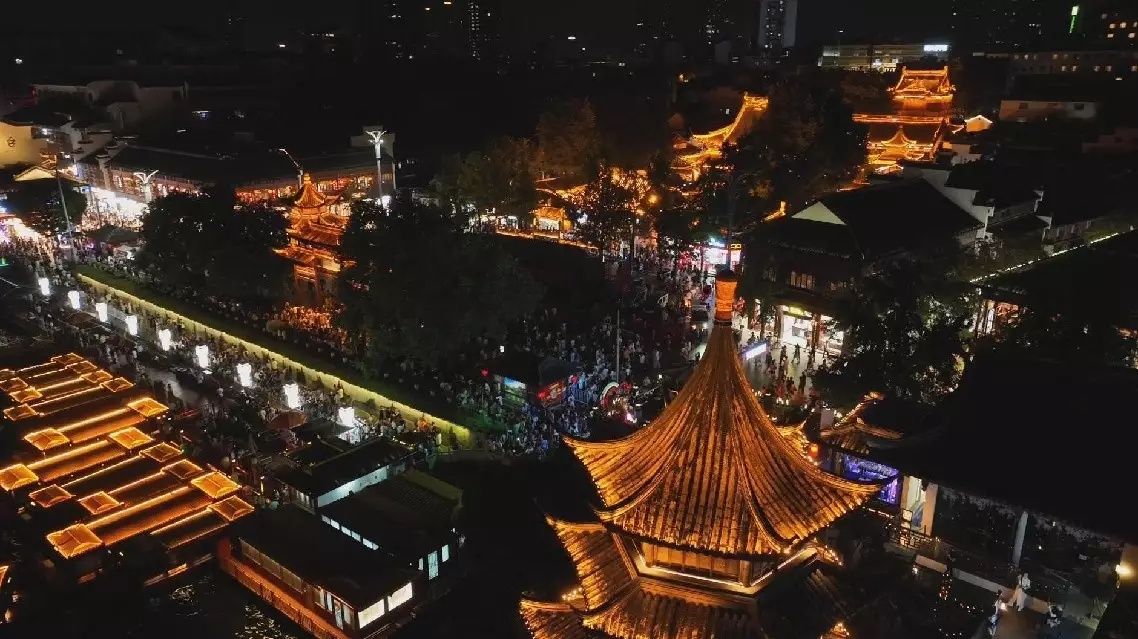A German vlogger recently embarked on a discovery trip to Nanjing, the capital of east China's Jiangsu Province, exploring ways the historic city is using modern technology and new business forms to give its cultural heritage a new lease of life.
The ancient city Nanjing, with a history of around 2,500 years, served as China's capital for six dynasties, which lasted from the early Three Kingdoms (220-280) to the end of the Southern Dynasties (420-589).
In October 2019, Nanjing became China's first City of Literature recognized by the United Nations Educational, Scientific and Cultural Organization (UNESCO) because of its long literary history and rich cultural accumulation.
The first stop of vlogger Judith Kahl's Nanjing trip was the World Literature Saloon. This was a project launched under a development program aimed at building a city-wide network of public literary spaces.
"The World Literature Saloon sits under the Jilong Mountain. It was once the site of the first literature museum in Chinese history. It is now open to the public as a literary activity center, exchange center, and exhibition center," said Wan Ziye, a guide at the saloon.
A vast selection of exhibits helps visitors better understand the connection between Nanjing and literature. The most eye-catching installation in the main building is a digital display showcasing the city's 1,800 years of literary history. It not only integrates important time nodes and works, but also allows visitors to interact with it to get more details about each masterpiece.
The saloon also serves as a place for public literature activities to promote the inheritance of the city's excellent culture.
Judith also visited a digital art exhibition that took people on a magical journey into the fantasy world of the 4th century Chinese book "The Classic of Mountains and Seas," browsing the pages in an innovative way.
The book is a classic Chinese text and a compilation of mythic geography and beasts. It is a fabulous geographical and cultural account of pre-Qin China, as well as a collection of Chinese mythology.
"Our exhibition is a digital disassembly of the ancient book 'The Classic of Mountains and Seas' through some digital light and shadow techniques," said Zhang Yi, the curator of the exhibition.
With dazzling artworks in various forms and diverse interactive installations, presenting the audience the traditional cultural heritage of ancient Chinese myth art through immersive experiences.
"The whole exhibition is full of various interesting interactive experiences, helping me to not only understand the wonderful stories and characters in the 'The Classic of Mountains and Seas,' but also feel the wisdom and imagination of ancient Chinese people through modern technology. After visiting this exhibition, I think the book 'The Classic of Mountains and Seas' is very interesting. In Germany, there are also many famous classics, such as Grimm's Fairy Tales, which everyone is very familiar with. I plan to promote this exhibition form after returning to Germany. I hope that our German classic literature can be better disseminated," said Judith.
As a big fan of Chinese epic masterpiece "A Dream of Red Mansions" written by Cao Xueqin in the Qing Dynasty (1644-1911), the German vlogger certainly wouldn't skip the Jiangning Imperial Silk Manufacturing Museum in the author's hometown.
The modern museum was built on the site of the former Jiangning Imperial Silk Manufacturing Bureau of the Qing dynasty, where Cao spent his childhood. It showcases part of the history and culture portrayed in the book.
In addition to a rich collection of cultural relics, the museum holds immersive performances based on the Chinese classic. Without a fixed stage and seats, the audience can fully enter the scene and interact with the characters.
"Our play has actually made an innovative exploration. Here, we combine digital art with stage designs, so that every visitor can enter the story itself from the first-person perspective and feel the charm of this classic work. We hope that we can make an immersive cultural tourism product through digital art combined with immersive experiences and various artistic expressions, so that these classic literary works can enter people's lives in a more vivid way," said Chen Hong, the show's producer.
Judith also went on a night-time sightseeing tour along the Confucius Temple-Qinhuai River scenic belt, a renowned spot that receives more than 50 million visits every year. She talked to tourists there to find out what draws people from all over the country to the ancient city.
"Nanjing was the ancient capital of six dynasties. Its cultural heritage is very strong.Confucian culture is very attractive to us," said a visitor.
"I feel the advancement of technology in Nanjing. The city is using more novel ways to promote traditional culture," said another visitor.
Like most tourists, Judith, donning traditional Han clothing, learned more about the city's history and culture while appreciating the exquisite historical architectures and the local style performances along the Qinhuai River leisurely on a beautifully painted boat.
"Through this trip, I found that Nanjing is a city both old and young. In this millennia-old ancient capital, I do not only feel the profound heritage of Chinese culture, but was also surprised to find that the history and culture still exude fresh vitality today. This trip brought too many surprises, and I need to slowly reflect on it in the future," said Judith.

German vlogger explores fusion of cultural heritage, modern technology in Nanjing









